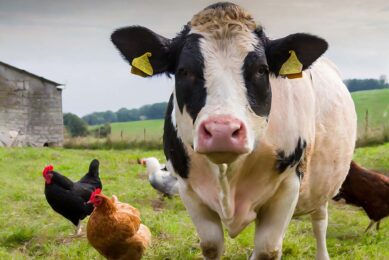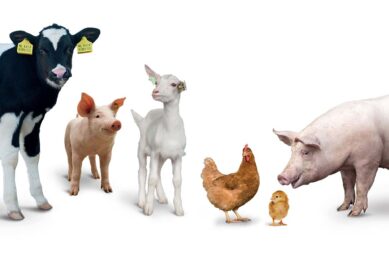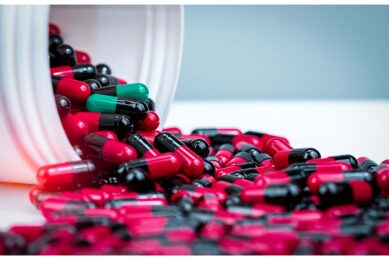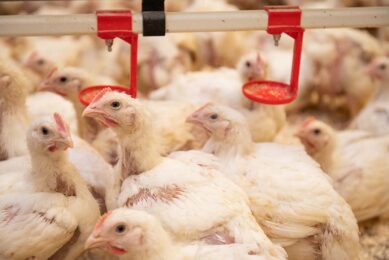The importance of feed additives to combat heat stress
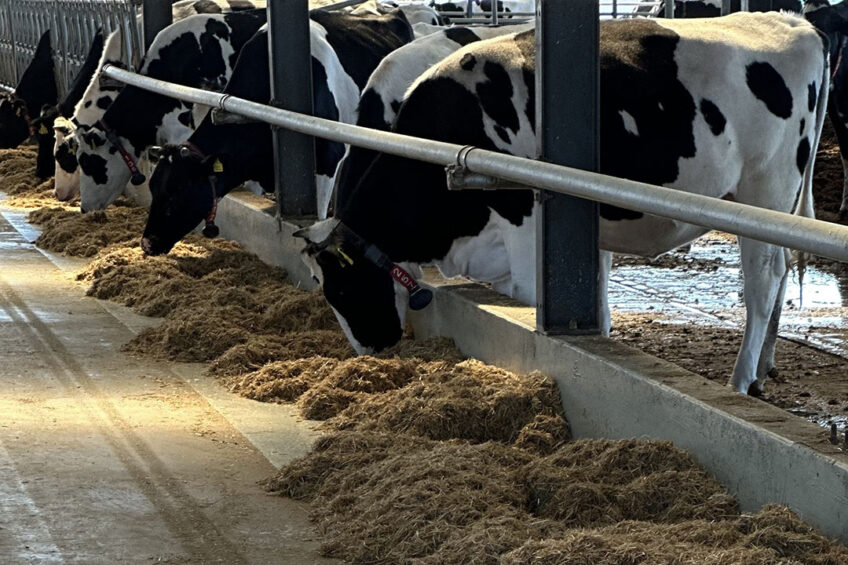
Globally, temperatures have increased by 1°C since the 1800s and are expected to continue to increase by another 1.5°C between 2030 and 2052. There is no doubt that Heat Stress (HS) affects (re-) productivity, nutrition, health, and welfare of dairy cattle. Managing HS has become more of a challenge than ever before as the increasing genetic potential of breed cows are directly linked with higher productivity, higher milk yield but also increased milk components (butter fat, proteins, solids etc.). The greater the genetic potential, the greater the metabolic activity required.
Dairy cows can regulate body temperature within an upper critical temperature and a lower critical temperature, but they can perform their maximum genetic potential only when the minimal physiological nutrient expenditure combined with the maximum productivity outcome which may be achieved only within their thermal neutral zone. Within their TNZ, a range of 5 to 25°C, the cow does not spend any additional energy to maintain its normal body temperature (39°C).
Understanding the direct and indirect effects of HS
HS could be characterised as a syndrome of complex biochemical, metabolic and behavioural reactions that occur in each individual cow when they are kept over and above their TNZ and cannot maintain their normal body temperature. To maintain constant body temperature cows try to regulate thermal energy balance which can happen only when the heat generated through metabolism (maintenance, growth, lactation, transition) is equal with the heat lost to the environment. By default, cows above TNZ regulate energy balance by slowing down the physiochemical functions, mainly in the rumen. With respect to behaviour, cows dramatically lower feed intake with all metabolic dysfunctions followed as a chain reaction to that.
Rumination dramatically increases body temperature from energy loses due to mechanic energy transforming into heat. With this logic applied, cows with healthier rumens, ruminating and fermenting their diet more efficiently, are the ones more susceptible to heat stress. Knowing that forage fermentation depresses, means energy balance tends to be negative for the cow. This also means acetic to propionic acid ratio alters within the rumen shifting pH to lower levels, the first step to milk fat depression. Negative energy balance means lower glucose levels (Figure 1) and significantly lower milk yield (72g of glucose required to produce 1 litre of milk. Lactose synthesis from glucose, primarily made from propionate, determines the amount of milk yield produced. Heat stressed cows secrete approx. 400g less lactose per day and utilising more systemic amino acids. This is limiting the amino acid supply to the mammary gland meaning lower milk protein synthesis. Alterations to metabolism and physiological processes under HS may also result in a decrease in milk protein yield.
Figure 1 – Major interactions between the immune, endocrine and metabolic systems in dairy cows during the transition period.
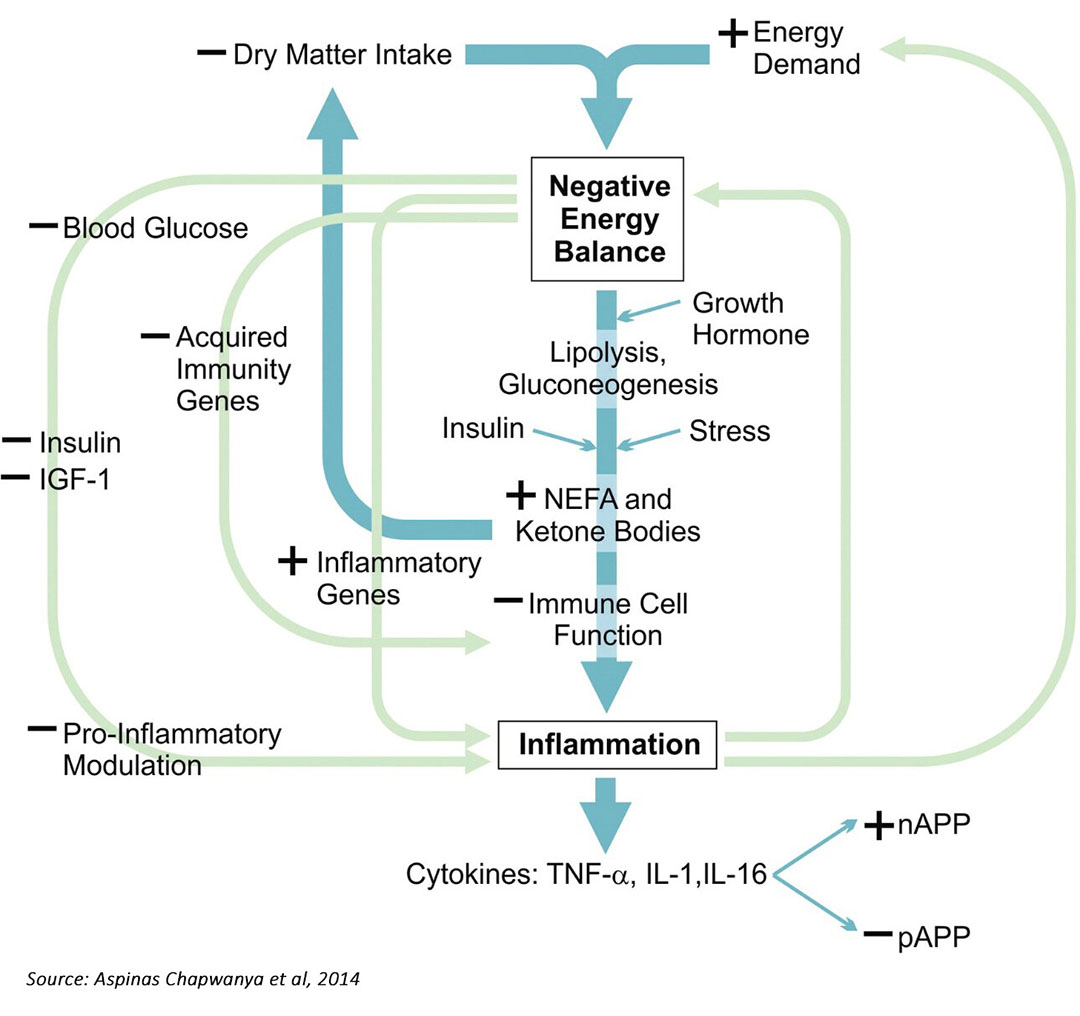
Gut health compromised
With diversion of blood flow to the skin to maximise radiant heat dissipation, apart from the rumen epithelium, gut health also impaired. Gut barrier impaired functionality can be described by inflammation mediators, such as cytokine production. Together with other immunity indicators, proliferation of immune cells, migration of lymphocytes to the udder and cell viability are lower due to heat stress. Some researchers state that HS greatly inhibits the activity of the interleukin-2 gene, which plays a crucial role in T-cell proliferation, an essential part of the immune response. This mutual disruption of the rumen and gut barrier can lead to the translocation of histamine and accumulation of endotoxins (lipopolysaccharides – LPS) into the bloodstream promoting further inflammation, stimulating fever and reducing further appetite. Researchers found that cows under HS appear to have hyperinsulinemia and high levels of catabolic hormones (glucagon, cortisol, epinephrine). There is a substantial increase in glucose consumption by activated immune cells, as glucose is their primary energy source. Even though cows reduce milk yield to save glucose, hypoglycaemia often develops following an LPS increase more likely because the immune system’s rate of glucose utilisation exceeds the capacity of the liver to export additional glucose and insulin sensitive tissues to reduce glucose disposal. In this regard, infection and inflammation redirect resources towards the immune system and not for the milk production. Understanding this nutrient shift requirements of the immune response consider it critical to develop strategies to mitigate production losses from cows under HS.
Efficient use of feed additives to mitigate production losses
Feed additive usage, in order to be efficient in mitigating HS impaired productivity, needs to focus on gut integrity and immune modulation in parallel to feed intake stimulation. There are several ingredients which may act this way to a certain extent but a combination of them can have a greater effect in maintaining a healthy rumen. This will sustain a relatively constant pattern of nutrient supply to the animal which in turn should optimise efficiency of nutrient use. Generally, a high quality TMR needs to be maintained with more easily digestible fibres and optimum protein and energy levels. The use of appropriate energy, minerals, vitamins, antioxidants, prebiotics and probiotics with balanced nutrition are highly essential to ameliorate HS in dairy cows.
Organic acids and their salts can be used as rumen modifiers, preventing ruminal pH drop (depending on their dissociation level) and stimulating ruminal growth. Under warm and humid conditions (favourable for mould), calcium propionate is a safe and an effective inhibitor of mould. The addition of calcium propionate to TMR may have the function of preventing feed corruption. Live yeast and yeast cell wall products during HS periods can decrease body temperature but studies show little effect on other performance or health parameters. Knowing that fibre digestion and rumen efficacy remains of high priority for heat stressed dairy cattle these are considered very important additives. With regards to fibre metabolism, Inulin can be added through the rations. Studies prove that Inulin significantly reduce the concentration of ammonia nitrogen and improves rumen nitrogen utilisation. There are also studies hypothesised that dietary supplementation of Inulin may affect lactation performance and lipid metabolites in the blood via regulating the rumen and immune function of intestinal lymphoid tissue.
Key vitamins and trace elements like ascorbic acid, selenium and vitamin E improved the immune function by positively influencing the chemotaxis, phagocytic capacity and oxidising property of neutrophils. Selenium supplementation can reduce the frequency of clinical mastitis and somatic cell count in heat stressed dairy cows. The use of encapsulated Niacin reduces the rectal temperatures in lactating cows. Similarly, supplementation of high bioavailability Zinc, Copper, Manganese and Iron augmented the development of immune organs such as thymus, spleen, lymph node and enhances the phagocytic activity of neutrophils and macrophages which are essential for the proliferation of immune cells and antibody production. Furthermore, additional supplementation of Vitamin A,D
3
,E, Biotin and β-Carotene can stimulate metabolism, increase plasma glucose, lower non-esterified fatty acids and support cows immune response to oxidative stress.
Due to metabolic adaptations to HS, amino acid oxidation increases resulting in a reduction in circulating amino acids. Balancing amino acid nutrition focusing on limiting amino acids, Lysine and Methionine is highly important because they play a vital role in the immune response. For cows under HS, the utilisation of amino acids for milk production is decreased and more emphasis is given to immune response and gluconeogenesis. In parallel to Methionine nutrition additional supplementation of Vitamin B9 (folate) will act as a necessary co-enzyme for the transfer of methyl groups and the conversion of homocysteine back to methionine. This explains why folate is also a crucial component of embryo development. Betaine on the other hand, also plays a crucial role in the methionine cycle acting as a substrate for the enzyme betaine homocysteine S-methyltransferase (BHMT), a precursor to methionine synthase, which converts homocysteine back to methionine. In addition to that, Betaine also have an osmoregulatory role and can improve ionic exchange within cells and minimise water loss from muscle tissue and gut cells.
Conclusion
Considering the overall trend of lower income over feed cost (IOFC) in the last few years, HS tends to further becomes a critical financial burden for the overall farm finances rather than just a seasonal issue per year. Milk butter fat and protein yield in relation to HS have great economic interest not only for the farm as an enterprise but for the dairy industry as well. Many dairies support premium pricing (and penalties) for greater (or lower) fat to protein yield and ratio.
Nowadays, updated nutritional models for breeding dairy cattle as well as the industry, follow-up on the supply-demand to certain nutritional additives and nutraceuticals, makes their availability crucial to meet the growing genetic potential.
References are available on request.




